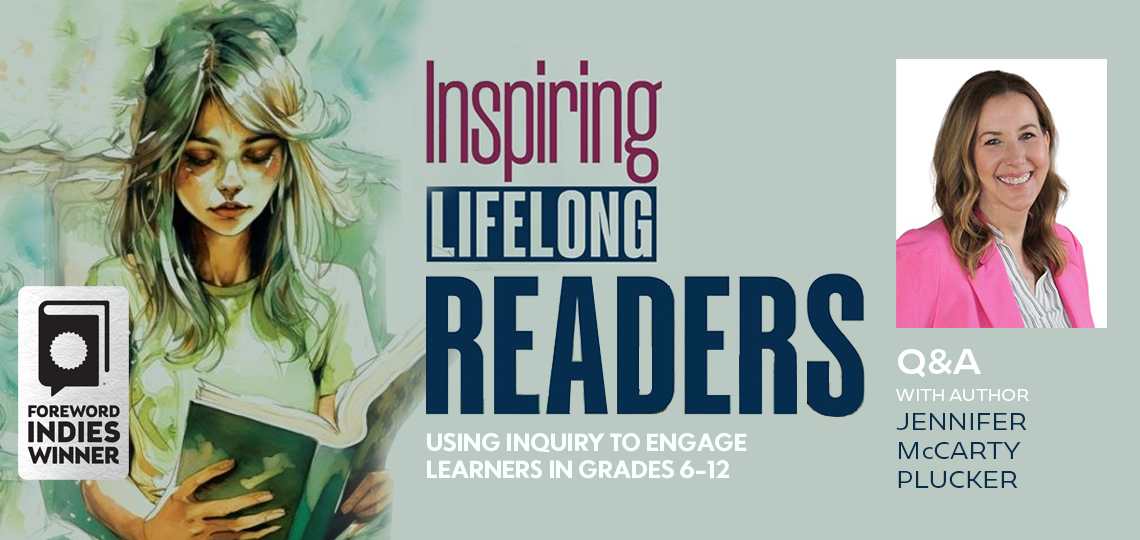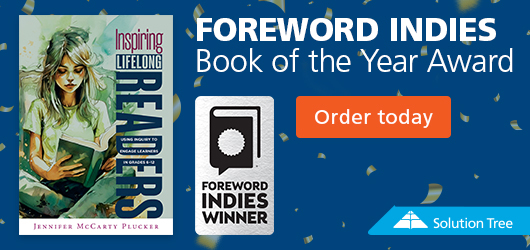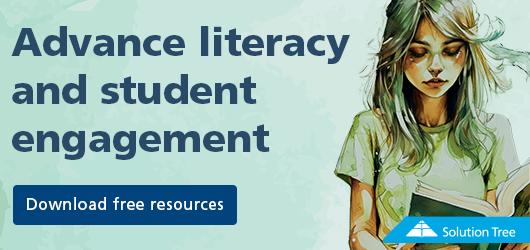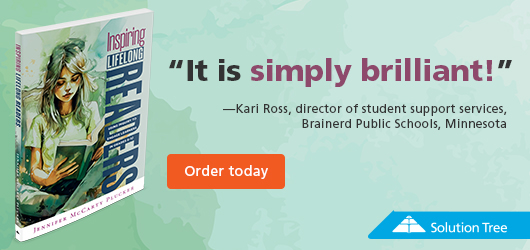Transform Students into Avid Readers

An Interview with Jennifer McCarty Plucker, Author of Inspiring Lifelong Readers: Using Inquiry to Engage Learners in Grades 6–12
Imagine going a whole day without reading a word—not on a street sign or tube of toothpaste or the screen on your phone. The idea is almost preposterous. Reading is essential to life in the twenty-first century.
All of which makes teaching those reading skills of critical importance to educators, and not just in early education. Our increasingly sophisticated society constantly introduces new forms of knowledge that needs to be learned by people of all ages. Literacy is a lifelong process.
No one understands this better than Jennifer McCarty Plucker—her Inspiring Lifelong Readers offers numerous strategies for teachers to help students of all ages and abilities become motivated and competent readers. Intrigued by Jennifer’s inquiry-based approach, we connected her with Foreword‘s Children’s Book Editor Danielle Ballantyne for an engaging conversation.
In the first few pages of your book, you reference an event that was somewhat transformative for you: a parent-teacher conference with the parent of one of your tenth-grade students who was having trouble comprehending the assigned reading. You acknowledge that you did not consider your role in fostering comprehension prior to that point, and you mention some dismissive attitudes from your colleagues that stuck out to you once your eyes were opened to this responsibility as if they considered students had reached an age where it was “too late” to teach literacy. How do you feel this mentality that literacy is something for elementary school or it’s a lost cause, so to speak, came about?
I am not sure where the mentality came about, but I do know that as a secondary education major, we were not taught about the process individuals go through when learning to read. I think the assumption was that a child learns to read in grades K–3 and then reads to learn in grades 4–12. I see this belief in the literature today. Once I better understood what is happening in our brains as we comprehend challenging texts, I realized that we continue to “learn to read” anytime we encounter new information, new vocabulary, new sentence structure, etc.
When I was in my quantitative research class, the statistics we were learning was a completely new language. I could decode the words on the page but had no idea what they meant. Unfortunately, some of our secondary students are coming to us unable to decode and they need middle and high school teachers who know how to advance the developmental literacy skills of whomever they have in front of them because it really is never too late.
I also think, as secondary educators, we have to realize the masks students wear to hide the literacy skill gaps they may have. We can’t dismiss learners as “lazy” or “slow.” This isn’t only disrespectful to the learner, it also usually is untrue. Some of my most savvy and brilliant students simply need the intentional instruction to accelerate their reading, writing, speaking, and collaboration skills so their strengths could shine.
You discuss in your book how students are often resistant to label themselves as “readers” because they have a particular image of what a “reader” has to be. Where do you think these stereotypes come from, and how would you suggest parents and educators combat them?
For my students, the stereotype was more of a misunderstanding of what it means to be a reader. Readers aren’t defined as “bookworms” or those who seem to always have a nose in a book. Yes, they are readers. However, readers are also individuals who seek knowledge in order to learn or master a skill. The student who studies crochet patterns and YouTube videos to make the cute vest for an upcoming country concert is a reader. The gamer who is reading all of the story inside the video game being played is a reader. And the young people who must have the captions on while watching their favorite TV shows and movies are readers. I think parents and educators can combat stereotypes associated with readers by modeling the type of reading they do. Some read manuals to better their woodworking. Others read leadership articles to improve their coaching. Sharing what we are interested in learning and how we go about getting the information we need to get better shows our young people that reading isn’t only for those in a book club.
In the section of your book related to building a structured classroom community, you explain a strategy you employ where, rather than policing your students during individual reading time, you have them keep track of distractions and their causes in a journal. This not only seems like less stress for the teacher, but it enables students to learn how to keep themselves on task without relying on someone to force them. How did you come up with that idea, and what were the benefits you saw in your classroom?
I discuss this in the book. This idea came when my teaching colleague and I were—probably at a happy hour—lamenting about how much “whack-a-mole” we were doing with behaviors in our classes during reading time. I was sharing how one student always broke out her mirror and makeup when it was time to read. Another always seemed to need to use the restroom. Others were quick to find friends to chat with or pull out their phones to scroll. We started to create a cast of characters:
Absent Ahmad—MIA, a lot.
Bobby Belligerent—The answer is always no!
Jack Jokester—Lots of jokes, often inappropriate.
Sleepy, Dopey, Droopy—Wait, are those dwarves?
Sneezy Sofia—Frequent visits to Nurse Peggy.
Charlie Charmer—Everybody’s buddy.
Forgetful Fay—No pencil, no notebook, no problem.
Billy Bladder—Suspiciously well-hydrated.
Celine Cell—So many texts, so little time.
Messy Malik—Something could be living in that backpack.
I-Couldn’t-Care-Less Chris—Surprisingly indifferent about everything.
While this was fun and made me feel better knowing my colleague was having the same issue, we wanted to find a way to get students to take ownership of managing their own distractions. So we shared this cast of characters with our students the next day. We didn’t single anyone out, and we shared the ways we tend to avoid getting into a zone, whether it is to read, meet a deadline, or complete a chore. Mine is “Online Shopper Olivia”—I get distracted by shopping sites while working on my computer and it draws me out of my zone. Then we brainstormed ways to set those characters aside, manage our distractions, and accomplish our goal of twenty minutes of uninterrupted reading.
Students appreciated learning that it was normal to experience avoidance behaviors and felt a sense of accomplishment when they managed to overcome distractions. When they took ownership of their focus and enjoyed the benefits of uninterrupted reading, I noticed a positive shift in our student-teacher relationship. No longer needing to constantly address off-task behaviors allowed us to connect on a deeper level.
You explore this topic thoroughly in your book, but can you talk to us a little bit about “inquiry-based learning” and how it differs from the approach we may be familiar with from our school days?
This is a big question and I do try to give it a thorough discussion in the book. If I were to simplify it, using the inquiry process would have us approach everything we learn from a stance of curiosity, questioning, and being open to multiple perspectives over a one-right answer. The biggest changes I made in moving from the more traditional teaching of English Language Arts to an inquiry approach was to abandon the idea that we would have a novel unit, an argument unit, a research paper unit, a short story unit, a grammar unit, a vocabulary unit … you probably get the idea. Instead, we start every unit with an essential question—something we could get curious about such as “Why museums? What stories do artifacts tell and how do they help us understand our world?” In English Language Arts, we aim to develop student writers, readers, thinkers, and communicators. We can immerse our young people in short stories, poetry, articles, TED Talks, art, novels, primary documents, and so much more to try to answer that question. Students can be writing, reading, and talking their way to a deeper understanding of something larger than the ELA classroom.
In the section “Honoring Student Voice,” you offer a suggestion to have students choose a “legacy book,” a book from the classroom library that had a lasting impact on them for some reason. They write their name, graduation year, and a few sentences about why the book impacted them on the inside of the front cover for future students to read and add to. What are some of the most popular “legacy book” selections you’ve seen amongst your students? Do you recall any choices that particularly surprised you?
This was a fun activity we did. I honestly wasn’t surprised by the books my students chose. Most of them chose the first book they read from start to finish and I believe that was more so associated with their immense sense of accomplishment than it was the story’s plot. This is why it is so important to take the time to get to know students’ interests, to have access to books across genres, in many different forms (novels in verse, high/low books, graphic novels, eBooks), and opportunities for students to try out a few before they commit to reading the entire book.
I remember one student choosing a hi/lo book published by Orca titled Juice, by Eric Walters, because he read it quickly, enjoyed it, and could have a full conversation about what he had read. Another student chose Harry Potter and The Sorcerer’s Stone, by J. K. Rowling, because he has always wanted to read it but was so intimidated by how many pages were in the book. It is probably no surprise to know that this student went on to read the entire series over the course of the school year and summer. I was surprised when a student chose Three Little Words, by Ashley Rhodes-Courter, because the story is about a young girl and her experiences in foster care. The reader was a popular young man and star basketball player on the school’s freshman team. It was a reminder to me that we can’t assume what books may or may not resonate with our readers.
You talk about the importance of having a classroom library that showcases diversity in regards to race, ethnicity, LGBTQ+ identities, religions, etc., but this is becoming difficult in some parts of the country where lawmakers are placing restrictions on what books teachers can provide or assign. If teachers are unable to have the titles they would like in the classroom, what are some methods you can think of for teachers to encourage their students to choose diverse books outside of it?
I do feel extremely grateful that I worked in an environment that understood the benefits of choice when it comes to advancing readers. Readers get better by reading. We create lifelong readers when we show students the vast amount of books, print and digital, available to them. When students choose books from the classroom library to read, I encourage them to share what they were reading with their parents and caregivers, friends, and others in their lives. When parents/caregivers came in for conferences, I encouraged them to have conversations with their children about what they were reading. When we talk about what we read, we deepen our reading experience.
If teachers are unable to have classroom libraries, I would still advocate for prioritizing independent reading. Most of our schools have libraries, many of our states provide access to ebooks for students, and almost all of our communities have public libraries. Thrift shops carry donated books. Our students need us to help them know where to get access to free/almost-free books and they need our help knowing how to find the right match. Again, we can only get better at reading, by reading.
Throughout the book, there are “Stories From the Field” that provide snapshots from your real-life experience as a literacy advocate and educator. Is there an anecdote that didn’t make it into the book that you’d like to share?
Over the last few years, I have had the profound privilege of working alongside other brilliant educators as they bring inquiry to their learners. One of my favorite projects was partnering with a team of educators who were teaching kindergarten in a charter school in Pittsburg, PA. They wanted students to engage in a project that would have some kind of positive impact on their community. We ended up doing a unit centered around the anchor text, Alex’s Lemonade Stand, with the essential question: how can ordinary kids use everyday talents for extraordinary purpose? The educators approached every task from a stance of curiosity.
Hey kindergartners, how was Alex an ordinary kid? What was Alex’s everyday talent? What did Alex do that was extraordinary? Do you think we could do something extraordinary?
The kindergartners spent the next five weeks reading informational texts, many about Alex, lemonade, and fundraising. They wrote an informational text on how to make lemonade. The students brainstormed how to make their own lemonade stand and considered who they could help with any money they earned. They chose to donate to help a young person from their community who was a Make-A-Wish candidate. Students were able to learn math standards related to counting and currency. They were able to apply some art standards as they created the backdrops for their green screen when they made commercials advertising their cause to their peers in the school. They mastered social studies standards related to community and citizenship. The teachers even snuck in some advanced science learning about acids and bases as students tasted lemons one day. Those photos are the cutest.
My biggest takeaway from this experience is that when we take an inquiry approach, we will likely be surprised, perhaps blown away, by our students’ engagement, performance, and achievement.
Are you working on any other projects currently? While we wait, what would you recommend for further reading on this subject?
Outside of consulting with educators, I am currently working with young people at a local Chick-fil-A on leadership development. I have been immersing myself in learning about how to empower youth. I had a mentor once tell me that our most underutilized resource is our children. They have unfiltered ideas and so much to contribute, if we adults took the time to listen. I have a lot of optimism for our future because of what I continue to learn from the teens I work with each day.
On the subjects of inquiry and student engagement in reading, my favorites include:
Igniting a Passion for Reading, by Steven Layne
Drive, by Daniel Pink
Cultivating Genius, by Gholdy Muhammad
Dive into Inquiry, by Trevor Mackenzie
Danielle Ballantyne



